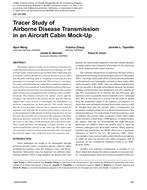Description
This paper reports a study on the airborne transmissionof the infectious disease(s) in the mock-up of a Boeing 767-300aircraft cabin, using a tracer gas method with a high temporalresolution. Carbon dioxide was used as the tracer gas to simulatethe pulse emitting such as coughing or sneezing of a sickpassenger in a commercial aircraft. The net tracer concentrationand a self-defined factor called the normalized cumulativefactor (CFN) were analyzed. A detailed description of the transientairborne transmission was obtained based on the contourmaps of tracer gas propagation from its release source to otherlocations. The distance between the release source and thereceptors, the location of the release source and the total airsupply rates were varied, to investigate the dependence ofairborne transmission on these factors. The results showedthat the close proximity between the occupants increased theexposure risk, and that the location of the release source wasan important factor affecting the airborne transmission. In realaircraft, one possible way to decrease the exposure risk of theinfectious diseases would be to move the release source fromthe center to the sides or from the back seats to the front seats.This would facilitate discharging a larger portion of theairborne pollutants directly to the return air duct before theywere spread to other locations in the aircraft cabin. Increasingthe total air supply rate could also lower the exposure risk.
Citation: ASHRAE Trans., vol. 112, pt. 2, paper no. QC-06-066, p. 697-705
Product Details
- Published:
- 2006
- Number of Pages:
- 9
- File Size:
- 1 file , 460 KB
- Product Code(s):
- D-28788




